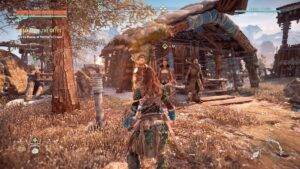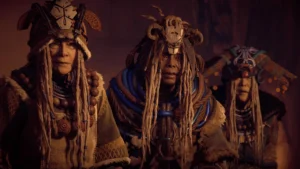For this week’s critical play, I played Horizon: Zero Dawn, a game developed by Guerilla Games initially as a Playstation exclusive, but now available on PC through Steam (which is how I played with an Xbox Controller). The game is an open-world Action RPG with themes of understanding, empowerment, and responsibility within a society. It is intended for young adults as there are depictions of violence. Horizon: Zero Dawn (H:ZD) was one of the first games of its genre to break the stereotypical mold of female protagonists and characters, building a “feminist story” by allowing players to empathize with Aloy and other characters, so they can “think with different perspectives and experiences.”
One of H:ZD strongest selling points, both in its narrative and the way it tells a feminist story is through its worldbuilding and environmental storytelling. H:ZD is set in a post-apocalyptic world where the Earth is roamed by mechanical beasts called Machines and there are rarely any non-mechanical animals in the wild. As a result, humanity has returned to hunter-gatherer societies, hunting the Machines for metal scraps and parts to maintain their weapons. There are many different tribes in H:ZD’s world, but for the beginning of the game, the tribe Aloy has most of her interactions with is the Nora. Uniquely, the Nora is a matriarchal tribe, believing that motherhood is the most important and sacred act. There are other tribes such as the Carja and the Oseram who do not share this belief.
A hunter who is the commander of her hunting group.
From the start of the game, we see the complexities of politics in H:ZD’s world. The Nora tribe is run by a group of elders called the High Matriarchs. Throughout the game, we see the development of the relationship between Nora and the High Matriarchs. We also see the motivations, flaws, and differing personalities of each of the matriarchs. For example, the matriarch Teersa is a compassionate matriarch, willing to help Aloy, an outcast, earn her place within the Nora by completing the tribe test called the Proving. We see this reflected in the personality and nature of Teersa as a calm, soft spoken woman. On the other hand, Lansra is a matriarch who heavily adheres to tribal law, and she is adamantly against Aloy joining the Nora because she was already outcast from the tribe as a child. Neither of these characters are portrayed as correct or perfect, instead they are given emotions, personalities, and motivations that the player has to untangle. This is a key point Shira Chess makes in chapter four of “Play Like a Feminist” claiming that feminist narratives are not necessarily overtly feminist but more empathetic and cohesive.
The three high matriarchs of the Nora tribe. From this image, we already see stark differences in their mannerisms and how they dress which reflect their natures as tribe leaders. (Left to right: Teersa, Jezza, Lansra)
Similarly, through our interactions with other characters as Aloy, we are able to develop our own personality and characteristic traits for her. The game never clearly instructs you to choose certain actions or dialogue to perform. For instance, one of the earliest memories Aloy has is of having a stone thrown at her by a Nora child after helping them pick berries, simply because she is an outcast. In this cutscene, players have the option of remaining passive, choosing to not escalate the situation, or retaliate in two different ways: insulting the boy or throwing the stone back. Of course, I chose to throw the stone back at the boy after which I was scolded by Rost, Aloy’s adoptive father, not for casting the stone back but for entering the village as an outcast. This is a common character trait of Aloy: being extremely curious, sometimes to her own detriment, and it is a character trait we rarely see in female protagonists. However, it’s a key driving force in the game, both mechanically and narratively, as Aloy explores areas to gather materials and her exploring the forbidden cave was how she gained The Focus, an item that is crucial to the storyline of H:ZD. Through her relationships with other characters, we also see more genuine, complete human interaction. Her interactions with Rost clearly show a deep, father-like love, but there are complexities as Aloy knows he is not her father. Many of Aloy’s love interests are also other women, but the player is also never forced into pursuing these relationships in the narrative.
Aloy, the main character
Overall, my interpretation of Chess’ feminist stories are ones that portray their female characters as fully developed human characters, all with their own motivations, backgrounds, conflicts, emotions, and other traits that make them human. This allows players to empathize with said characters and as a result, they are able to enjoy the game more. H:ZD is one of the only AAA games where I have seen its characters and world built so harmoniously, and it was only possible because the developers and story writers chose to approach the development of H:ZD with a feminist lens.






